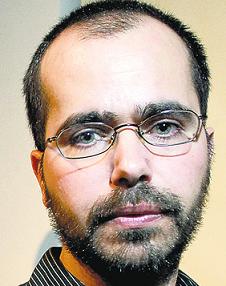Cyborg Professor to Implant Camera on Back of Head

Share
Hi Art, I'd like you to meet Cybernetics. I think the two of you are going to get along just fine.
Modern artists have done a lot of strange things for the sake of their craft, and Wafaa Bilal is no exception. The Iraqi-American photography and performance artist is a professor of photography at the New York University Tisch School of the Arts. His latest project will turn him into a cyborg. "The 3rd I" will involve Bilal undergoing surgery to have a small thumbnail sized camera embedded in the back of his head. Every minute or so, the camera will capture a still photo and transmit it to the Mathaf Arab Museum of Modern Art in Qatar, which commissioned the piece. Starting on December 15th and continuing for a year, visitors to Mathaf will get to see what's happening behind Bilal's head. This bizarre project has already generated controversy over privacy concerns on the NYU campus. As strange as a backwards facing camera may be, I'm excited by Bilal's venture into cybernetics. Leave it to art to push the boundaries of the public's acceptance of modern technology.
Wafaa Bilal isn't the first professor to wear a camera into class, nor is he the first video-enabled cyborg to stream video across the world. Steven Mann was pioneering that concept decades ago. Yet Bilal is one of the first people I've heard of to surgically attach a camera to his skull that isn't compensating for a loss of vision in his eyes. There's a level of commitment there that speaks to the general affinity the artist must feel for the camera he's going to be wearing 24/7/365.
Of course, it's the continuous nature of the camera that's also the problem. According to the Wall Street Journal, faculty and administrators at NYU have expressed concerns that Bilal's camera could invade the privacy of his students. Now, remember this camera is only going off every minute, and it's only capturing what's directly behind him. Still, maybe they have a point. Maybe it would be a little intrusive to sit in class, watching your professor write on the board, and know that a bunch of tourists in Qatar were watching blurry photos of you on a museum wall. To spare his students from such a crippling nightmare, Bilal has agreed to wear a cap over the camera while on NYU property. Problem solved?
Clearly not. But from what I can tell, the controversy surrounding "The 3rd I" project is more about Bilal than it is about cameras on campus. Since 2004, the artist has continually pushed social conventions while exploring concepts of war and terrorism. In 2007 he locked himself in a gallery where people could remotely access a paintball gun via the internet. He described this project ("Domestic Tension"), in his book Shoot an Iraqi. 2008 saw the arrival of "Virtual Jihadi", wherein Bilal hacked a poorly remade version of the ill-conceived Quest for Saddam video game. Using his face on a suicide-bomber's body, the game involves Bilal hunting down George W. Bush. In June of this year, Bilal debuted "...and Counting" which involved him being tattooed with the cities of Iraq, complete with dots marking the casualties of the ongoing war. Major media outlets focus on these projects as evidence of Bilal's edgy artistic past. Watching him describe "Domestic Tension" in the video below, the guy seems less controversial than he does concerned.
Be Part of the Future
Sign up to receive top stories about groundbreaking technologies and visionary thinkers from SingularityHub.


The funny thing about worrying about how "The 3rd I" project could affect privacy at NYU is that students are probably taking pictures much more frequently than Bilal. Most college students have mobile phones and most mobile phones have cameras. Some with streaming video. Part of living in the 21st Century is coping with the fact that public places are constantly full of cameras. Implanting one on the back of your head is cool, but hardly a large attack on privacy.
It's hard to know how to put Bilal's project into perspective. Is resistance to "The 3rd I" a sign of opposition that all those interested in life-logging will have to face in the years ahead? Or are we simply seeing a reaction to a controversial artist spilling over into his less controversial projects? Either way, I think that we still have a ways to go before society fully accepts those who wear cameras, cyborg or otherwise.
[image credit: Associated Press via WSJ]
[video credit: City Light Books ]
[source: WSJ, Wafaa Bilal site]
Related Articles

This Light-Powered AI Chip Is 100x Faster Than a Top Nvidia GPU

These Robots Are the Size of Single Cells and Cost Just a Penny Apiece

How Scientists Are Growing Computers From Human Brain Cells—and Why They Want to Keep Doing It
What we’re reading
